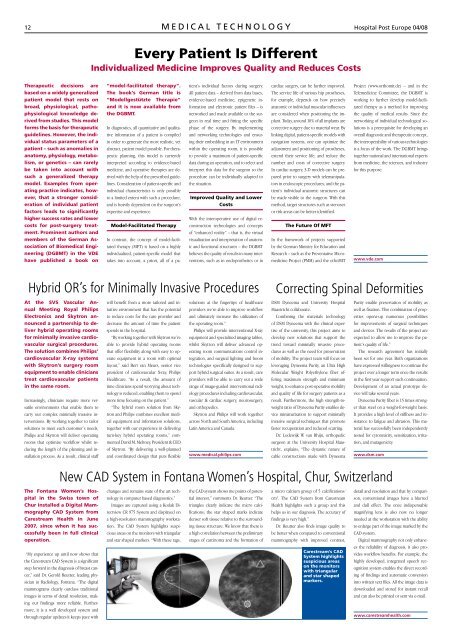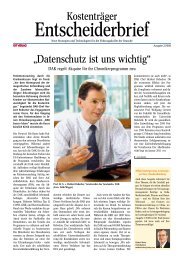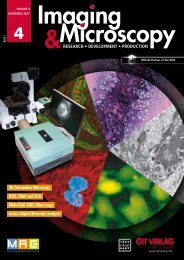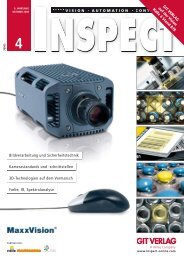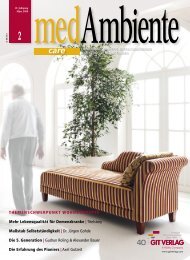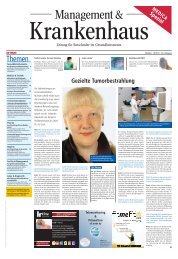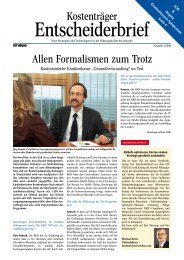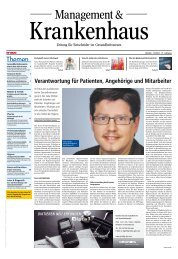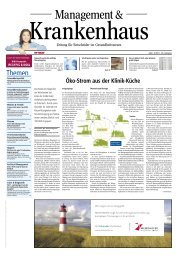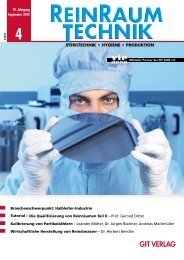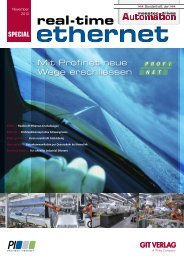Europe - GIT Verlag
Europe - GIT Verlag
Europe - GIT Verlag
Create successful ePaper yourself
Turn your PDF publications into a flip-book with our unique Google optimized e-Paper software.
12 MEdIcAL tEcHnoLoGY<br />
Hospital Post <strong>Europe</strong> 04/08<br />
Therapeutic decisions are<br />
based on a widely generalized<br />
patient model that rests on<br />
broad, physiological, pathophysiological<br />
knowledge derived<br />
from studies. This model<br />
forms the basis for therapeutic<br />
guidelines. However, the individual<br />
status parameters of a<br />
patient – such as anomalies in<br />
anatomy, physiology, metabolism,<br />
or genetics – can rarely<br />
be taken into account with<br />
such a generalized therapy<br />
model. Examples from operating<br />
practice indicates, however,<br />
that a stronger consideration<br />
of individual patient<br />
factors leads to significantly<br />
higher success rates and lower<br />
costs for post-surgery treatment.<br />
Prominent authors and<br />
members of the German Association<br />
of Biomedical Engineering<br />
(DGBMT) in the VDE<br />
have published a book on<br />
Every Patient Is Different<br />
Individualized Medicine Improves Quality and Reduces Costs<br />
“model-facilitated therapy”.<br />
The book’s German title is<br />
“Modellgestützte Therapie”<br />
and it is now available from<br />
the DGBMT.<br />
In diagnostics, all quantitative and qualitative<br />
information of a patient is compiled<br />
in order to generate the most realistic, yet<br />
abstract, patient model possible. For therapeutic<br />
planning, this model is currently<br />
interpreted according to evidence-based<br />
medicine, and operative therapies are derived<br />
with the help of the prescribed guidelines.<br />
Consideration of patient-specific and<br />
individual characteristics is only possible<br />
to a limited extent with such a procedure,<br />
and is heavily dependent on the surgeon’s<br />
expertise and experience.<br />
Model-Facilitated Therapy<br />
In contrast, the concept of model-facilitated<br />
therapy (MFT) is based on a highly<br />
individualized, patient-specific model that<br />
takes into account, a priori, all of a pa-<br />
tient’s individual factors during surgery.<br />
All patient data – derived from data bases,<br />
evidence-based medicine, epigenetic information<br />
and electronic patient files – is<br />
networked and made available to the surgeon<br />
in real time and fitting the specific<br />
phase of the surgery. By implementing<br />
and networking technologies and ensuring<br />
their embedding in an IT environment<br />
within the operating room, it is possible<br />
to provide a maximum of patient-specific<br />
data during an operation, and to select and<br />
interpret this data for the surgeon so the<br />
procedure can be individually adapted to<br />
the situation.<br />
Improved Quality and Lower<br />
Costs<br />
With the interoperative use of digital reconstruction<br />
technologies and concepts<br />
of “enhanced reality” – that is, the virtual<br />
visualization and interpretation of anatomic<br />
and functional structures – the DGBMT<br />
believes the quality of results in many interventions,<br />
such as in endoprothetics or in<br />
Hybrid OR’s for Minimally Invasive Procedures<br />
At the SVS Vascular Annual<br />
Meeting Royal Philips<br />
Electronics and Skytron announced<br />
a partnership to deliver<br />
hybrid operating rooms<br />
for minimally invasive cardiovascular<br />
surgical procedures.<br />
The solution combines Philips’<br />
cardiovascular X-ray systems<br />
with Skytron’s surgery room<br />
equipment to enable clinicians<br />
treat cardiovascular patients<br />
in the same room.<br />
Increasingly, clinicians require more versatile<br />
environments that enable them to<br />
carry out complex minimally invasive interventions.<br />
By working together to tailor<br />
solutions to meet each customer’s needs,<br />
Philips and Skytron will deliver operating<br />
rooms that optimize workflow whilst reducing<br />
the length of the planning and installation<br />
process. As a result, clinical staff<br />
will benefit from a more tailored and intuitive<br />
environment that has the potential<br />
to reduce costs for the care provider and<br />
decrease the amount of time the patient<br />
spends in the hospital.<br />
“By working together with Skytron we’re<br />
able to provide hybrid operating rooms<br />
that offer flexibility along with easy to operate<br />
equipment in a room with optimal<br />
layout,” said Bert van Meurs, senior vice<br />
president of cardiovascular X-ray, Philips<br />
Healthcare. “As a result, the amount of<br />
time clinicians spend worrying about technology<br />
is reduced, enabling them to spend<br />
more time focusing on the patient.”<br />
“The hybrid room solution from Skytron<br />
and Philips combines excellent medical<br />
equipment and information solutions,<br />
together with our experience in delivering<br />
turn-key hybrid operating rooms,” commented<br />
David M. Mehney, President & CEO<br />
of Skytron. “By delivering a well-planned<br />
and coordinated design that puts flexible<br />
solutions at the fingertips of healthcare<br />
providers we’re able to improve workflow<br />
and ultimately increase the utilization of<br />
the operating room.”<br />
Philips will provide interventional X-ray<br />
equipment and specialized imaging tables,<br />
whilst Skytron will deliver advanced operating<br />
room communications control integration,<br />
and surgical lighting and boom<br />
technologies specifically designed to support<br />
hybrid surgical suites. As a result, care<br />
providers will be able to carry out a wide<br />
range of image-guided interventional radiology<br />
procedures including cardiovascular,<br />
vascular & cardiac surgery, neurosurgery,<br />
and orthopedics.<br />
Skytron and Philips will work together<br />
across North and South America, including<br />
Latin America and Canada.<br />
www.medical.philips.com<br />
cardiac surgery, can be further improved.<br />
The service life of various hip prostheses,<br />
for example, depends on how precisely<br />
anatomic or individual muscular influences<br />
are considered when positioning the implant.<br />
Today, around 10% of all implants are<br />
corrective surgery due to material wear. By<br />
linking digital, patient-specific models with<br />
navigation systems, one can optimize the<br />
adjustment and positioning of prostheses,<br />
extend their service life, and reduce the<br />
number and costs of corrective surgery.<br />
In cardiac surgery, 3-D models can be prepared<br />
prior to surgery with telemanipulators<br />
in endoscopic procedures, and the patient’s<br />
individual anatomic structures can<br />
be made visible to the surgeon. With this<br />
method, target structures such as stenoses<br />
or risk areas can be better identified.<br />
The Future Of MFT<br />
In the framework of projects supported<br />
by the German Ministry for Education and<br />
Research – such as the Preventative Micromedicine<br />
Project (PMM) and the othoMIT<br />
Project (www.orthomit.de) – and in the<br />
Telemedicine Committee, the DGBMT is<br />
working to further develop model-facilitated<br />
therapy as a method for improving<br />
the quality of medical results. Since the<br />
networking of individual technological solutions<br />
is a prerequisite for developing an<br />
overall diagnostic and therapeutic concept,<br />
the interoperability of various technologies<br />
is a focus of the work. The DGBMT brings<br />
together national and international experts<br />
from medicine, the sciences, and industry<br />
for this purpose.<br />
www.vde.com<br />
Correcting Spinal Deformities<br />
DSM Dyneema and University Hospital<br />
Maastricht collaborate.<br />
Combining the materials technology<br />
of DSM Dyneema with the clinical expertise<br />
of the university, this project aims to<br />
develop new solutions that support the<br />
trend toward minimally invasive procedures<br />
as well as the need for preservation<br />
of mobility. The project team will focus on<br />
leveraging Dyneema Purity, an Ultra High<br />
Molecular Weight Polyethylene fiber offering<br />
maximum strength and minimum<br />
weight, to enhance post-operative mobility<br />
and quality of life for surgery patients as a<br />
result. Furthermore, the high strength-toweight<br />
ratio of Dyneema Purity enables device<br />
miniaturization to support minimally<br />
invasive surgical techniques that promote<br />
faster recuperation and reduced scarring.<br />
Dr. Lodewijk W. van Rhijn, orthopedic<br />
surgeon at the University Hospital Maastricht,<br />
explains, “The dynamic nature of<br />
cable constructions made with Dyneema<br />
Purity enable preservation of mobility as<br />
well as fixation. This combination of properties<br />
opens-up numerous possibilities<br />
for improvements of surgical techniques<br />
and devices. The results of the project are<br />
expected to allow me to improve the patient’s<br />
quality of life.”<br />
The research agreement has initially<br />
been set for one year. Both organizations<br />
have expressed willingness to continue the<br />
project over a longer term once the results<br />
in the first year support such continuation.<br />
Development of an actual prototype device<br />
will take several years.<br />
Dyneema Purity fiber is 15 times stronger<br />
than steel on a weight-for-weight basis.<br />
It provides a high level of stiffness and resistance<br />
to fatigue and abrasion. This material<br />
has successfully been independently<br />
tested for cytotoxicity, sensitization, irritation,<br />
and mutagenicity.<br />
www.dsm.com<br />
New CAD System in Fontana Women’s Hospital, Chur, Switzerland<br />
The Fontana Women’s Hospital<br />
in the Swiss town of<br />
Chur installed a Digital Mammography<br />
CAD System from<br />
Carestream Health in June<br />
2007, since when it has successfully<br />
been in full clinical<br />
operation.<br />
“My experience up until now shows that<br />
the Carestream CAD System is a significant<br />
step forward in the diagnosis of breast cancer,”<br />
said Dr. Gerold Reutter, leading physician<br />
in Radiology, Fontana. “The digital<br />
mammograms clearly outclass traditional<br />
images in terms of detail resolution, making<br />
our findings more reliable. Furthermore,<br />
it is a well developed system and<br />
through regular updates it keeps pace with<br />
changes and remains state of the art technology<br />
in computer based diagnostics.”<br />
Images are captured using a Kodak Directview<br />
CR 975 System and displayed on<br />
a high-resolution mammography workstation.<br />
The CAD System highlights suspicious<br />
areas on the monitors with triangular<br />
and star shaped markers. “With these tags,<br />
the CAD system shows me points of potential<br />
interest,” comments Dr. Reutter. “The<br />
triangles clearly indicate the micro calcifications;<br />
the star shaped marks indicate<br />
denser soft tissue relative to the surrounding<br />
tissue structure. We know that there is<br />
a high correlation between the preliminary<br />
stages of carcinoma and the formation of<br />
a micro calcium group of 5 calcifications/<br />
cm 2 . The CAD System from Carestream<br />
Health highlights such a group and this<br />
helps us in our diagnosis. The accuracy of<br />
findings is very high.”<br />
Dr. Reutter also finds image quality to<br />
be better when compared to conventional<br />
mammography with improved contrast,<br />
Carestream’s CAD<br />
System highlights<br />
suspicious areas<br />
on the monitors<br />
with triangular<br />
and star shaped<br />
markers.<br />
detail and resolution and that by comparison,<br />
conventional images have a blurred<br />
and dull effect. The once indispensable<br />
magnifying lens is also now no longer<br />
needed at the workstation with the ability<br />
to enlarge part of the image marked by the<br />
CAD system.<br />
Digital mammography not only enhances<br />
the reliability of diagnosis, it also provides<br />
workflow benefits. For example, the<br />
highly developed, integrated speech recognition<br />
system enables the direct recording<br />
of findings and automatic conversion<br />
into written text files. All the image data is<br />
downloaded and stored for instant recall<br />
and can also be printed or sent via e-mail.<br />
www.carestreamhealth.com


